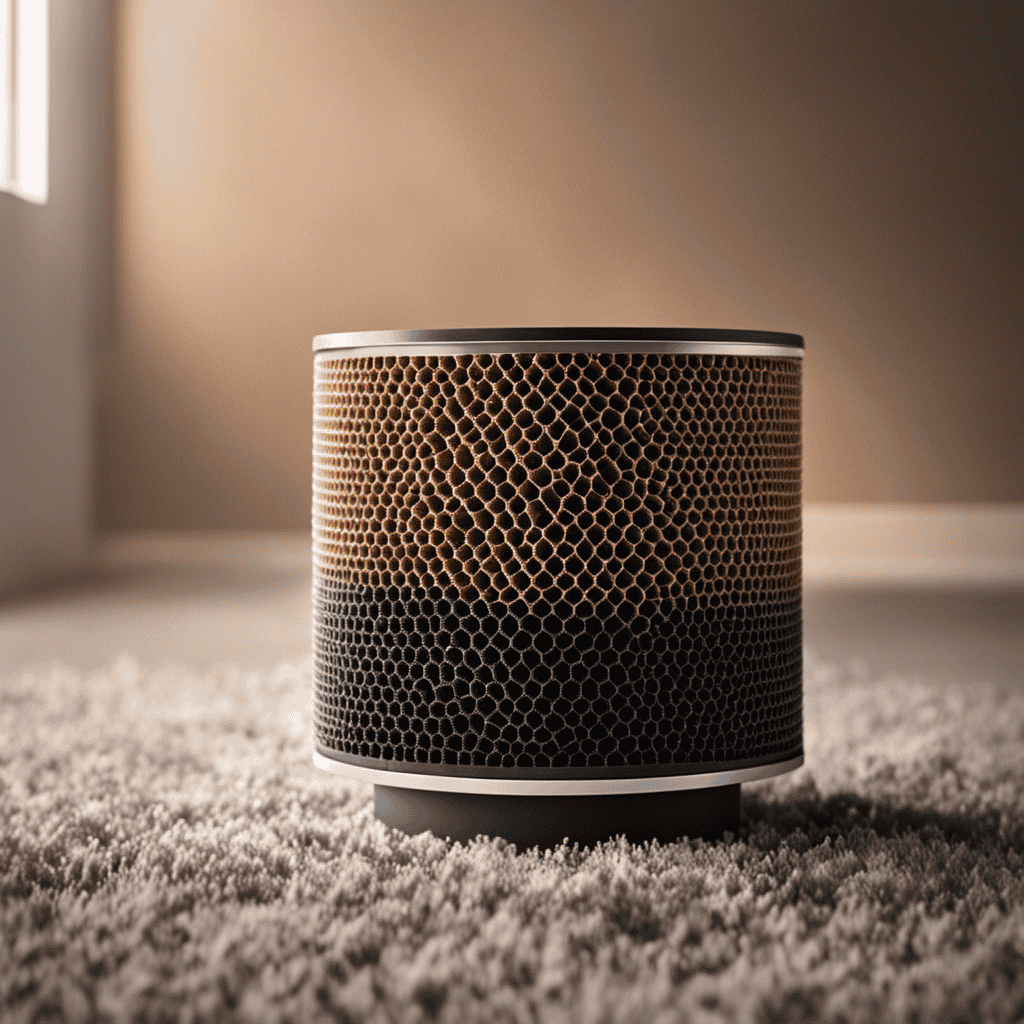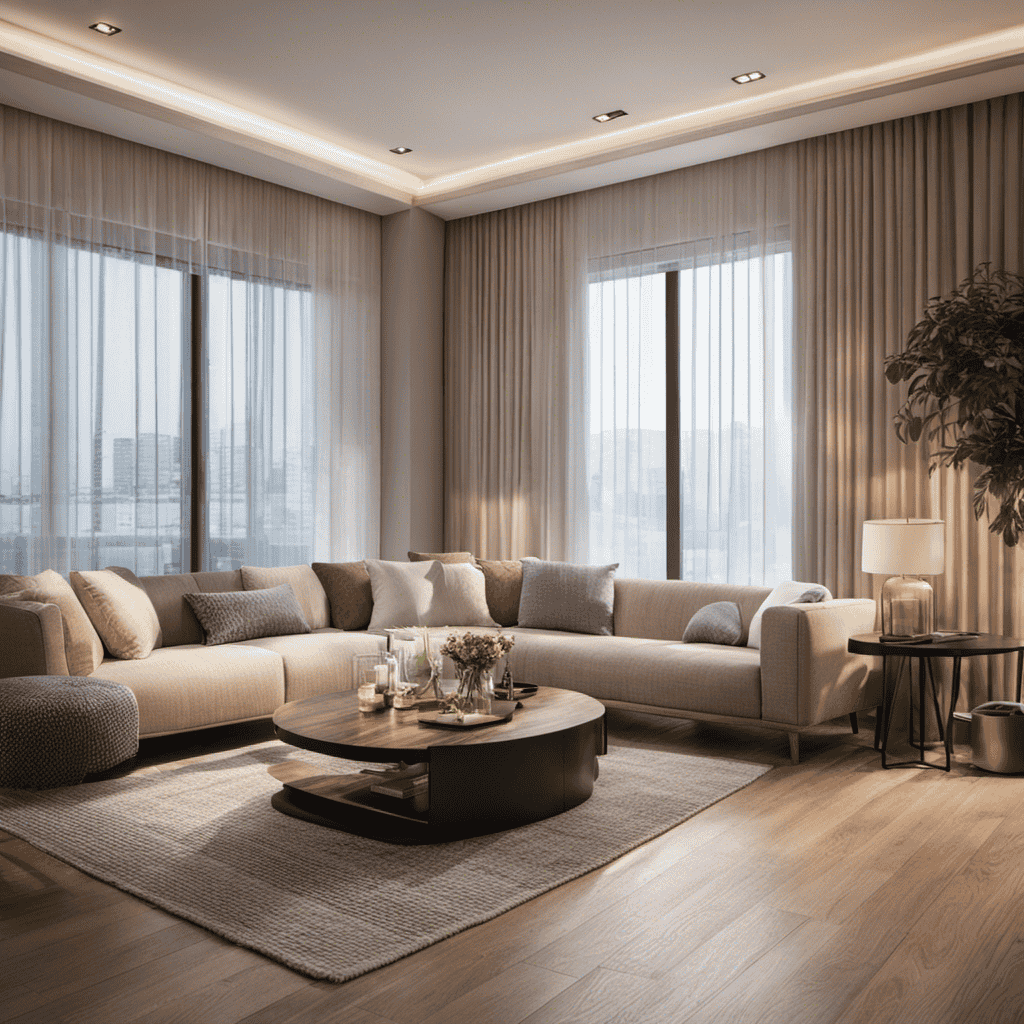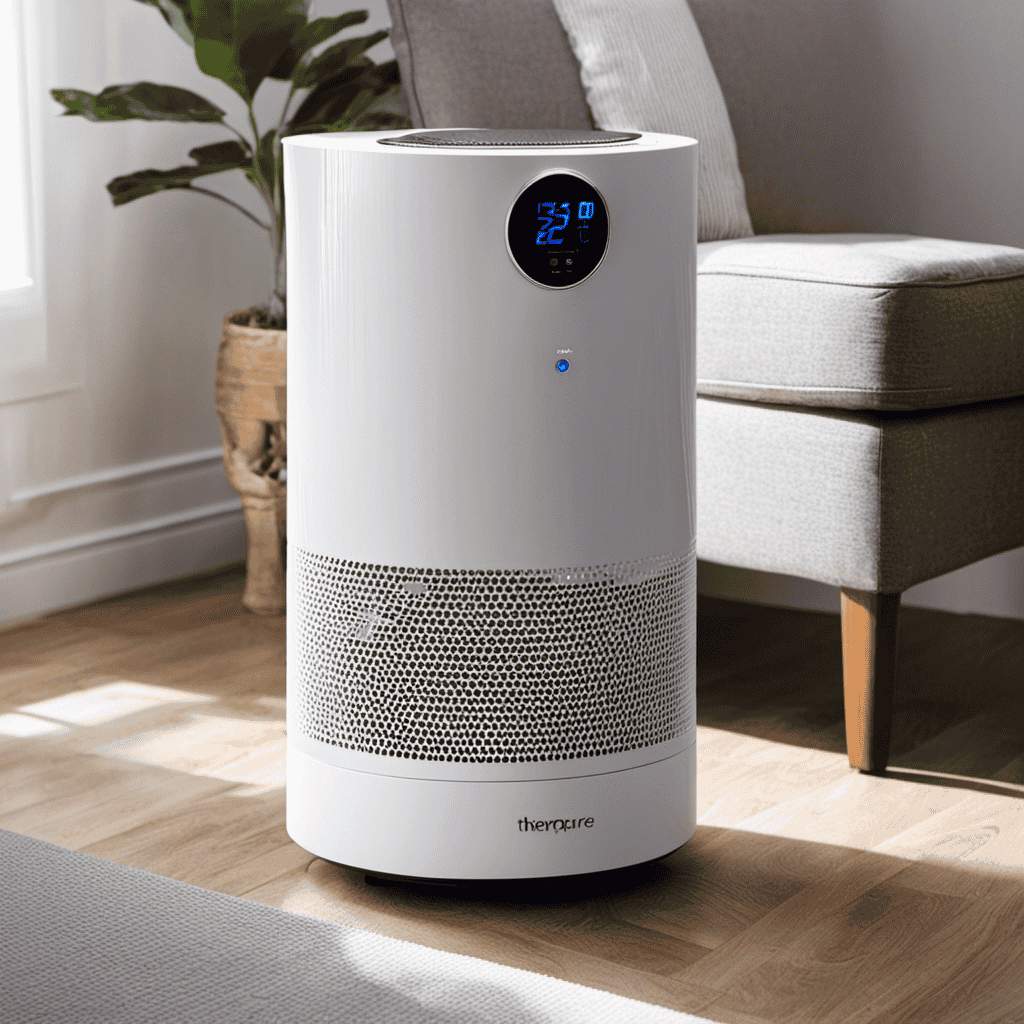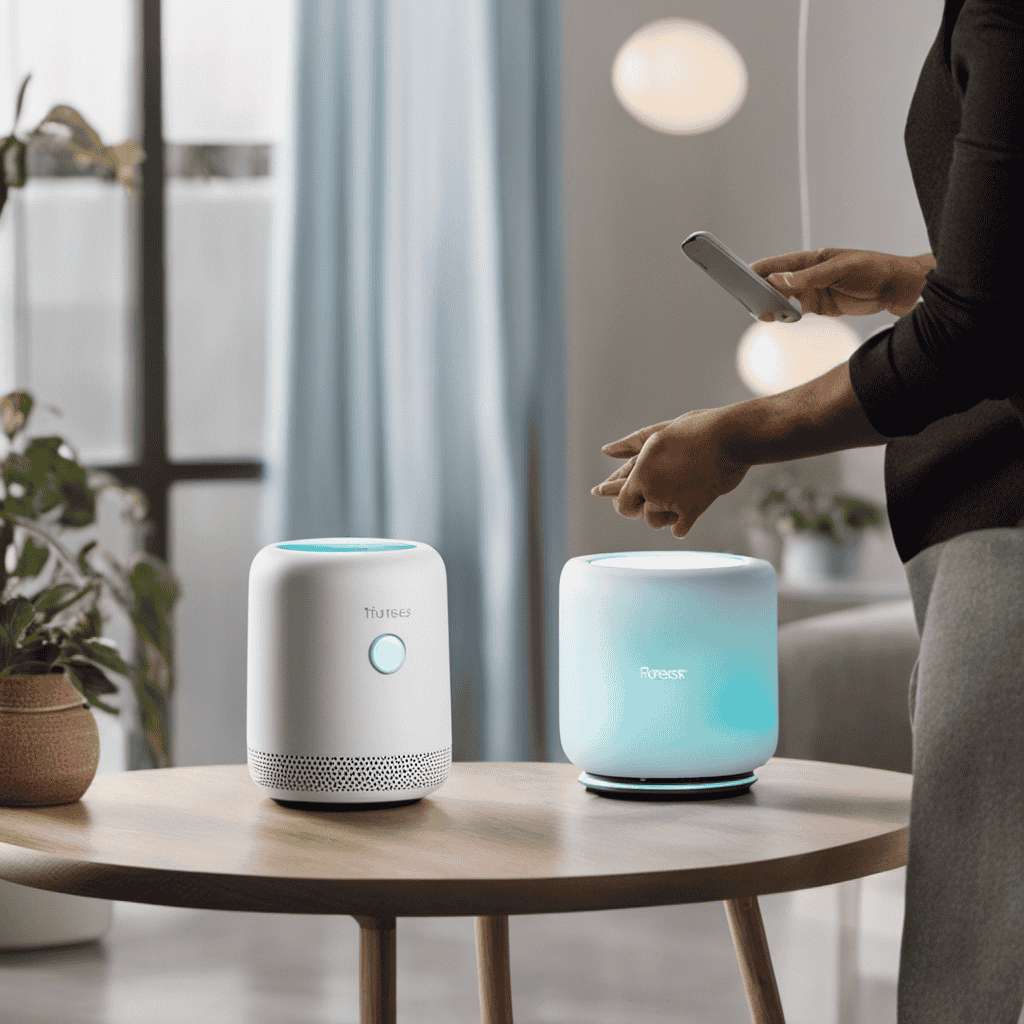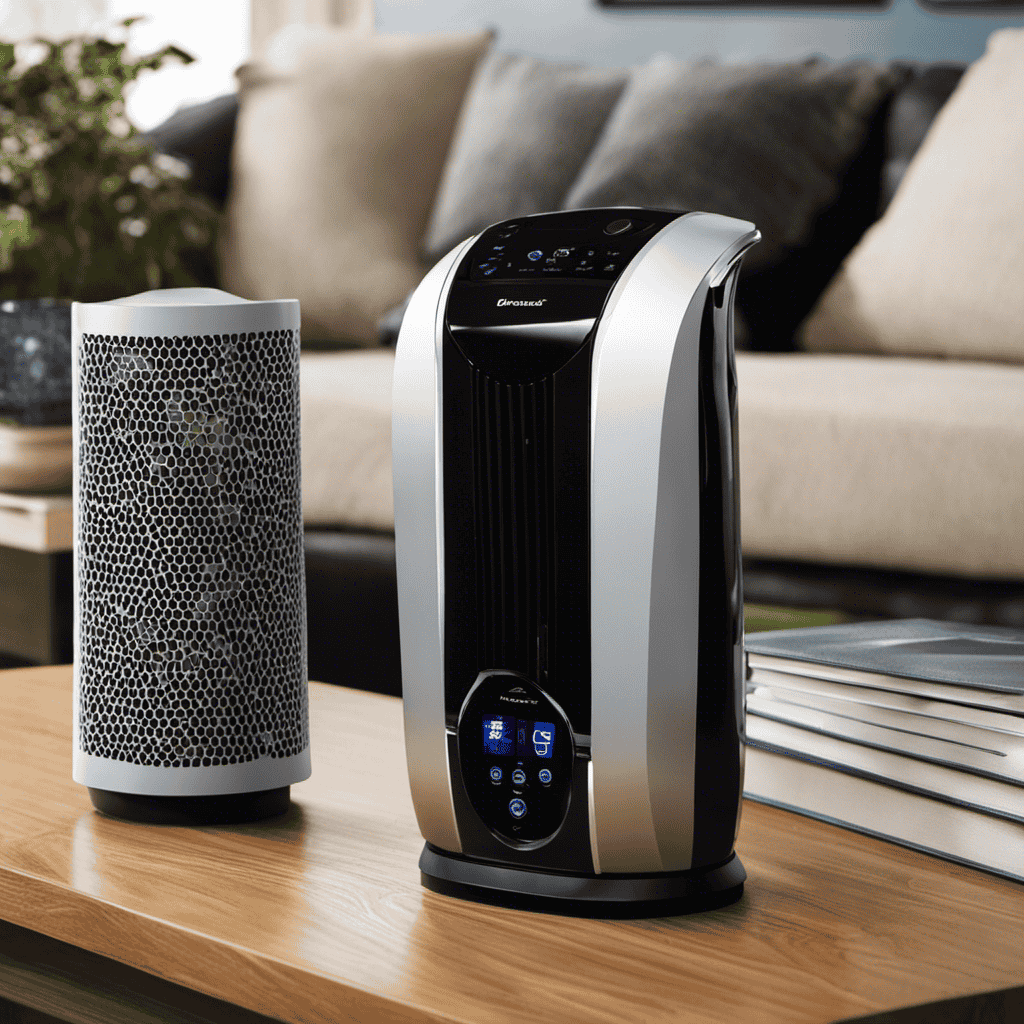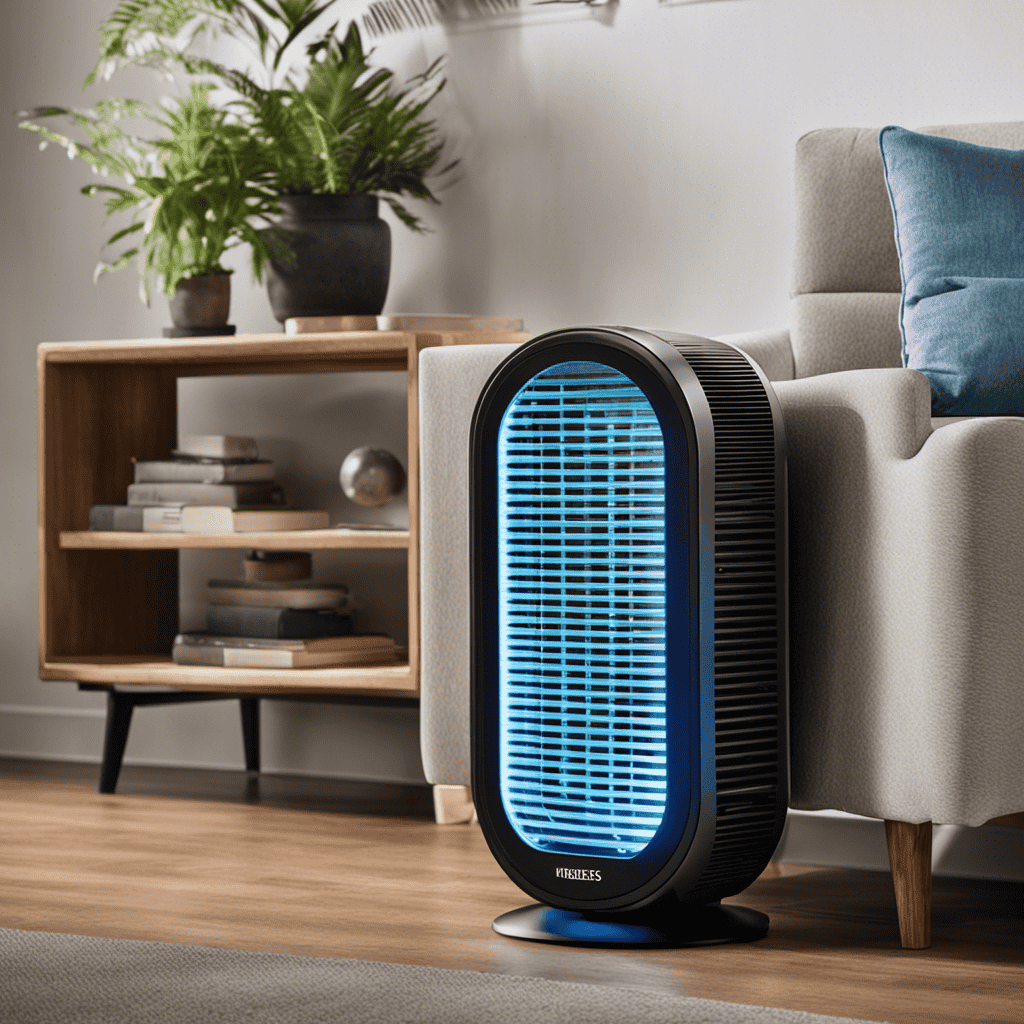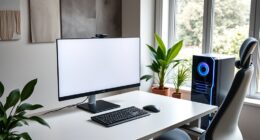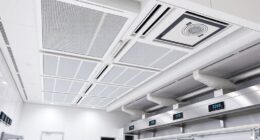As a proud owner of an air purifier, I’ve learned that the filter is essential to the device’s effectiveness. It is the silent champion tirelessly working to ensure the air in our homes remains pure and fresh.
But have you ever wondered how often you should change this vital component? In this article, we’ll delve into the factors that affect filter lifespan, recommended change frequency, signs that indicate replacement, and tips to extend its life.
So, let’s dive in and ensure that our air purifiers continue to breathe life into our spaces.
Key Takeaways
- Air quality in your home affects filter lifespan
- Regular monitoring and cleaning of the filter is essential
- Recommended filter change frequency is typically every six months
- Different types of filters have varying lifespans
Factors Affecting Filter Lifespan
One of the factors that affects the lifespan of the filter in an air purifier is the air quality in your home. The filter efficiency plays a crucial role in determining how long it will last.
If your air purifier has a high-quality filter with excellent efficiency, it can effectively trap and remove airborne particles, such as dust, pollen, pet dander, and smoke. This means that the filter will be exposed to a higher concentration of pollutants, leading to faster clogging.
On the other hand, if the filter has a lower efficiency, it may take longer to get clogged. Regularly monitoring the filter’s condition and replacing it when necessary is essential to maintain optimal air purification performance.
Recommended Filter Change Frequency
The recommended frequency for replacing the filter in an air purifier is typically every six months. Regular filter replacement is crucial to ensure optimal performance and maintain clean indoor air quality.
Over time, the filter accumulates dust, allergens, and other pollutants, which can hinder its effectiveness. By adhering to a regular filter replacement schedule, you can ensure that your air purifier continues to function efficiently.
In addition to following the recommended replacement frequency, there are also filter maintenance techniques that can help prolong its lifespan. These include regular cleaning, such as vacuuming or rinsing, to remove larger particles and debris. It is also important to monitor the filter’s condition and replace it sooner if it appears dirty or clogged.
Signs That Your Filter Needs Replacement
If you notice reduced airflow or a musty odor, it’s time to replace your filter. Common filter problems can arise when the filter becomes clogged with debris or dust over time. This can hinder the airflow and reduce the effectiveness of your air purifier.
To prevent this, it is important to clean or replace the filter regularly. One popular filter cleaning technique is to use a vacuum cleaner to remove any visible debris or dust particles. However, this may not remove all the trapped contaminants. In such cases, it is recommended to replace the filter entirely.
Regularly checking and cleaning or replacing your filter will ensure optimal performance and maintain clean air in your space.
Extending Filter Lifespan: Maintenance Tips
To keep your filter in good condition and make it last longer, it’s important to regularly clean or replace it. Here are some effective filter cleaning techniques and DIY filter maintenance tips that will help you extend the lifespan of your filter:
-
Vacuuming: Use a vacuum cleaner with a brush attachment to remove dust and debris from the surface of the filter. Make sure to vacuum gently to avoid damaging the filter material.
-
Washing: Some filters can be washed with water and mild detergent. Follow the manufacturer’s instructions for proper cleaning. Allow the filter to dry completely before reinstalling it.
-
Compressed Air: Use compressed air to blow off the dust and dirt from the filter. Hold the canister upright and spray in short bursts from a distance to avoid damaging the filter.
-
Pre-Filter Cleaning: If your air purifier has a pre-filter, clean it regularly by vacuuming or washing it. This will prevent larger particles from clogging the main filter and ensure better performance.
How to Properly Replace an Air Purifier Filter
When replacing an air purifier filter, it’s essential to follow the manufacturer’s instructions and ensure the filter is installed correctly. Properly replacing the filter is crucial for maintaining the efficiency of your air purifier and ensuring clean air in your home.
To start, consult the air purifier maintenance checklist provided by the manufacturer. This checklist will guide you through the necessary steps for replacing the filter, including turning off the unit, removing the old filter, and installing the new one.
It’s important to note that clean air in the home offers numerous benefits, such as reducing allergies, preventing respiratory issues, and improving overall health. By following the proper procedure for filter replacement, you can continue to enjoy these benefits and maintain a healthy living environment.
Now, let’s explore the different types of filters and their lifespan.
Different Types of Filters and Their Lifespan
When it comes to air purifiers, understanding the longevity of each filter type is crucial in maintaining optimal indoor air quality. Different filters, such as HEPA, carbon, and electrostatic, have varying lifespans based on their design and usage.
Knowing the optimal filter replacement frequency for each type ensures that your air purifier continues to effectively remove pollutants and allergens from the air, providing you with clean and healthy indoor air.
Filter Longevity for Each Type
The longevity of each type of filter varies. Here is a breakdown of the lifespan of different filters commonly used in air purifiers:
-
Pre-filter: This filter captures large particles like dust and pet hair. It should be replaced every 3 months or as needed, depending on the level of pollutants in your environment.
-
Activated carbon filter: This filter absorbs odors and chemicals. It typically lasts for 6 to 12 months, but this can vary depending on usage and the amount of contaminants in the air.
-
HEPA filter: This filter removes small particles such as pollen, mold spores, and bacteria. It usually needs to be replaced every 12 to 18 months, although some models may require more frequent replacements.
-
UV-C filter: This filter uses ultraviolet light to kill bacteria and viruses. It doesn’t need to be replaced, but the UV-C bulb may need to be changed every 12 to 18 months.
To ensure optimal performance, it is important to follow the recommended filter replacement schedule and proper filter maintenance techniques.
Optimal Filter Replacement Frequency
The lifespan of each type of filter can vary, so it’s important to follow the recommended replacement schedule. Regularly replacing your air purifier’s filters is crucial for maintaining optimal performance and improving indoor air quality. The frequency of filter replacement depends on various factors, including the filter type, usage, and the air quality in your environment. By increasing filter efficiency, you can effectively prolong the lifespan of your filters. The impact of air quality on filter lifespan is significant. Higher levels of pollutants and contaminants in the air can lead to faster clogging and reduced filter effectiveness. To help you understand the recommended replacement frequency for different filter types, refer to the table below:
| Filter Type | Recommended Replacement Frequency |
|---|---|
| Pre-filter | Every 1-3 months |
| HEPA filter | Every 6-12 months |
| Carbon filter | Every 3-6 months |
Following these guidelines will ensure that your air purifier continues to effectively remove pollutants from the air, creating a healthier living environment.
Cost Considerations: Filter Replacement Expenses
You’ll want to factor in the cost of filter replacements when considering the expenses of owning an air purifier. While air purifiers are a great investment for maintaining clean and healthy indoor air, it’s important to understand the ongoing costs associated with filter replacements.
Here are some key points to consider:
-
Filter brand comparison: Different air purifiers use different types of filters, and the cost of replacement filters can vary significantly between brands. It’s important to research and compare the prices of replacement filters before making a purchase.
-
DIY filter cleaning methods: Some air purifier filters can be cleaned and reused, saving you money on frequent replacements. However, not all filters are washable, so make sure to check the manufacturer’s instructions before attempting to clean them.
-
Filter lifespan: Filters have a limited lifespan and need to be replaced when they become clogged or ineffective. The lifespan of a filter depends on factors such as the level of pollutants in your environment and how often you use the air purifier.
-
Replacement frequency: It is recommended to replace air purifier filters every 6 to 12 months, although this can vary depending on the specific model and usage. Regularly replacing filters ensures that your air purifier continues to provide optimal filtration and maintains its effectiveness in removing airborne pollutants.
Considering these factors will help you make an informed decision about the ongoing costs of owning an air purifier and help you budget accordingly.
What Are the Consequences of Not Changing the Air Purifier Filter Regularly?
Neglecting to maintain the air purifier filter replacement frequency can lead to several negative consequences. Over time, a clogged filter will reduce the unit’s efficiency, allowing harmful particles to circulate in the air. This can exacerbate allergies, asthma, and other respiratory issues, as well as decrease overall air quality.
Frequently Asked Questions
Can I Clean and Reuse the Filter Instead of Replacing It?
I can clean and reuse the filter instead of replacing it. However, it is important to note that cleaning may not be as effective as replacing for optimal air purification.
Can I Use a Different Brand of Filter in My Air Purifier?
Using a different brand of filter in your air purifier may void the warranty and compromise its performance. However, if compatible, a HEPA filter offers the benefit of efficiently capturing harmful particles and improving indoor air quality.
Is It Necessary to Change the Pre-Filter as Frequently as the Main Filter?
I clean my pre-filter regularly to maintain optimal performance. Using a high-quality filter ensures better air purification and prolongs the lifespan of the main filter. Frequency of pre-filter cleaning may vary depending on usage and air quality.
Can I Extend the Lifespan of the Filter by Running the Air Purifier on a Lower Speed Setting?
Running the air purifier on a lower speed setting may extend the filter’s lifespan. However, it’s important to maintain the performance by regularly changing the filter. Running on a higher speed setting can reduce filter lifespan.
How Do I Properly Dispose of a Used Air Purifier Filter?
Proper disposal methods for used air purifier filters are crucial to minimize the environmental impact. It is important to follow local regulations and guidelines when disposing of these filters to ensure they are handled and recycled appropriately.
Conclusion
In conclusion, changing the filter in your air purifier is absolutely crucial for maintaining a healthy and clean indoor environment. Neglecting to do so could result in a disaster of epic proportions!
Okay, maybe not that dramatic, but seriously, the consequences of not changing your filter regularly can lead to decreased efficiency, increased allergies, and even potential health risks.
So, don’t take any chances! Stay on top of your filter replacement schedule and breathe easy knowing that you’re doing everything you can to keep your air pure and fresh.
